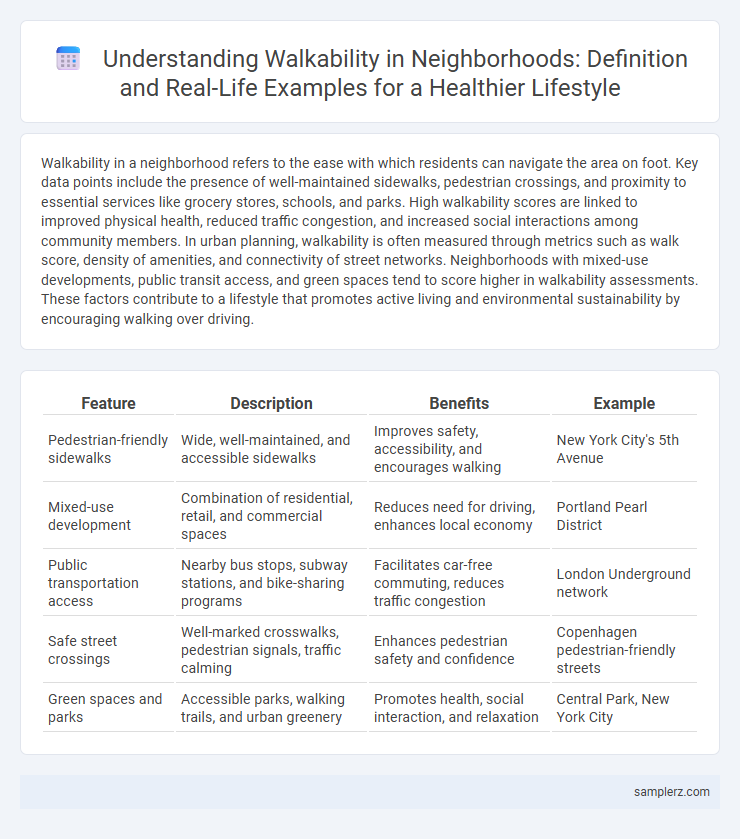Walkability in a neighborhood refers to the ease with which residents can navigate the area on foot. Key data points include the presence of well-maintained sidewalks, pedestrian crossings, and proximity to essential services like grocery stores, schools, and parks. High walkability scores are linked to improved physical health, reduced traffic congestion, and increased social interactions among community members. In urban planning, walkability is often measured through metrics such as walk score, density of amenities, and connectivity of street networks. Neighborhoods with mixed-use developments, public transit access, and green spaces tend to score higher in walkability assessments. These factors contribute to a lifestyle that promotes active living and environmental sustainability by encouraging walking over driving.
Table of Comparison
| Feature | Description | Benefits | Example |
|---|---|---|---|
| Pedestrian-friendly sidewalks | Wide, well-maintained, and accessible sidewalks | Improves safety, accessibility, and encourages walking | New York City's 5th Avenue |
| Mixed-use development | Combination of residential, retail, and commercial spaces | Reduces need for driving, enhances local economy | Portland Pearl District |
| Public transportation access | Nearby bus stops, subway stations, and bike-sharing programs | Facilitates car-free commuting, reduces traffic congestion | London Underground network |
| Safe street crossings | Well-marked crosswalks, pedestrian signals, traffic calming | Enhances pedestrian safety and confidence | Copenhagen pedestrian-friendly streets |
| Green spaces and parks | Accessible parks, walking trails, and urban greenery | Promotes health, social interaction, and relaxation | Central Park, New York City |
Defining Walkability and Its Importance in Neighborhoods
Walkability refers to how friendly an area is for walking, characterized by factors such as the presence of sidewalks, safe crossings, and proximity to essential amenities like grocery stores, parks, and public transit. High walkability enhances neighborhood health by encouraging physical activity, reducing traffic congestion, and fostering social interactions among residents. Urban planners prioritize walkability to create sustainable, accessible communities that support active lifestyles and improve overall quality of life.
Key Features of a Walkable Neighborhood
Wide sidewalks, well-marked crosswalks, and ample street lighting are key features of a walkable neighborhood that promote safety and accessibility for pedestrians. Proximity to essential amenities such as grocery stores, parks, schools, and public transit reduces reliance on vehicles and enhances convenience. Mixed-use development, including residential, commercial, and recreational spaces, fosters an engaging environment conducive to walking.
Real-Life Examples of Walkable Communities
Portland, Oregon exemplifies a walkable community with its compact urban design, interconnected sidewalks, and mixed-use development promoting foot traffic to local shops and parks. In Arlington, Virginia, a network of pedestrian-friendly streets and accessible public transit encourages residents to walk to restaurants, schools, and offices. Similarly, Copenhagen, Denmark's extensive bike lanes and pedestrian zones illustrate how infrastructure supports daily walking and cycling, enhancing urban lifestyle and reducing car dependence.
The Role of Mixed-Use Development in Walkability
Mixed-use development significantly enhances neighborhood walkability by integrating residential, commercial, and recreational spaces within close proximity, reducing the need for car travel. This urban planning strategy encourages pedestrian movement by providing accessible amenities, such as grocery stores, cafes, and parks, directly within walking distance. Studies indicate that neighborhoods with higher mixed-use density report increased foot traffic and improved community health outcomes.
Benefits of Walkable Neighborhoods for Health and Wellbeing
Walkable neighborhoods encourage physical activity by providing safe, accessible sidewalks and nearby amenities such as parks, grocery stores, and cafes, which help reduce obesity and cardiovascular risk. Residents benefit from improved mental health through increased social interaction and reduced stress levels associated with traffic and pollution. Enhanced walkability also supports healthier lifestyles by making daily routines more active and environmentally sustainable.
Accessibility to Public Transit Enhancing Walkability
Neighborhoods with high walkability feature seamless accessibility to public transit, reducing reliance on cars and encouraging pedestrian movement. Conveniently located bus stops, subway stations, and bike-sharing hubs foster easy connectivity, promoting healthier lifestyles and lowering carbon footprints. Enhanced transit accessibility stimulates local economies as residents opt for walking and transit over driving, boosting community interaction and overall quality of life.
How Green Spaces Foster Walkable Environments
Green spaces significantly enhance neighborhood walkability by providing safe, shaded pathways and natural areas that encourage pedestrian activity. Parks, tree-lined streets, and community gardens create inviting environments for walking, promoting physical health and social interaction. Access to well-maintained green spaces increases property values and supports sustainable urban development.
Successful Urban Planning for Walkable Streets
Successful urban planning for walkable streets prioritizes mixed-use developments, pedestrian-friendly infrastructure, and efficient public transit connections. Features such as wide sidewalks, frequent crosswalks, and traffic-calming measures enhance safety and accessibility, encouraging residents to choose walking over driving. Cities like Copenhagen and Portland serve as prime examples, demonstrating increased community engagement and reduced carbon emissions through walkable neighborhood designs.
Community Initiatives Improving Local Walkability
Community initiatives such as neighborhood walking groups, improved pedestrian signage, and local park enhancements significantly boost walkability by encouraging residents to explore their environment safely and comfortably. Collaborative efforts between city planners and community members often result in wider sidewalks, better lighting, and traffic calming measures that enhance pedestrian accessibility. These grassroots programs not only promote healthy lifestyles but also foster social connections within neighborhoods.
Future Trends in Neighborhood Walkability
Future trends in neighborhood walkability emphasize integrating smart technology such as AI-powered pedestrian signals and real-time air quality monitoring to enhance safety and health. Urban planners are prioritizing mixed-use developments and pedestrian zones that reduce car dependency, promoting sustainable mobility options like bike-sharing and electric scooters. Data-driven approaches to design ensure accessible, inclusive, and green public spaces, fostering community connectivity and active lifestyles.

example of walkability in neighborhood Infographic
 samplerz.com
samplerz.com